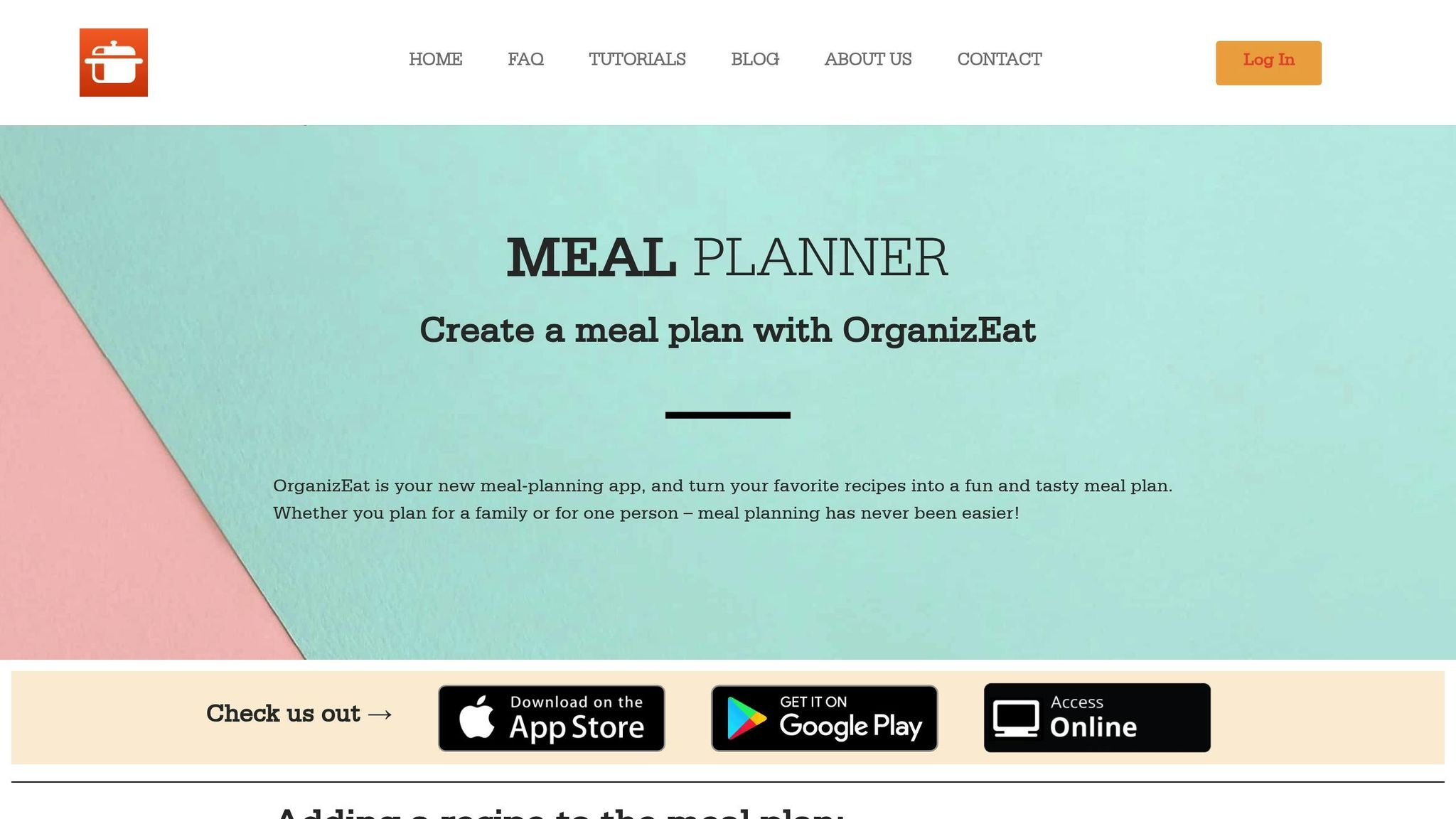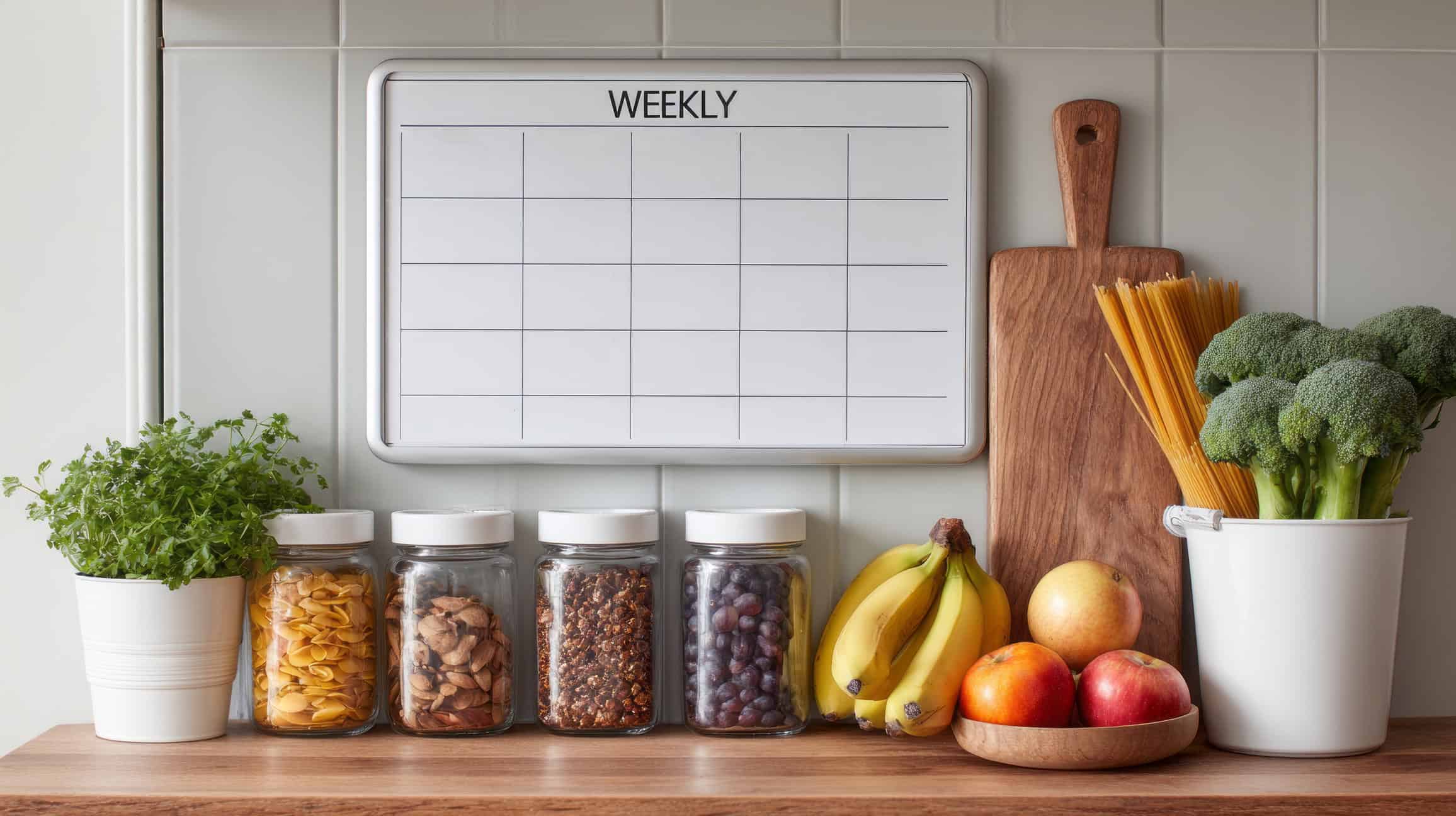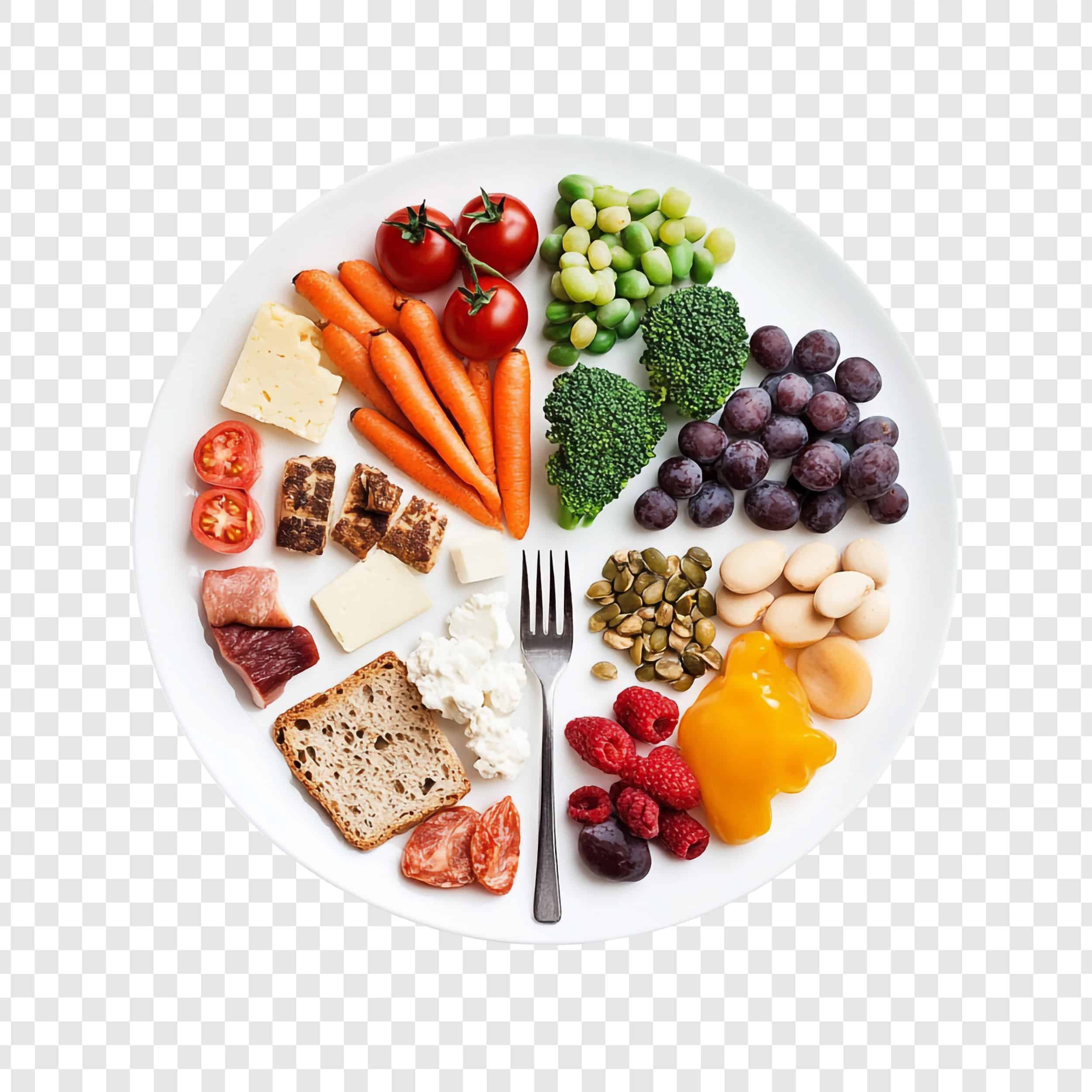Managing dietary restrictions can feel overwhelming, but meal planning simplifies the process. Whether you’re gluten-free, lactose-intolerant, vegan, or managing diabetes, the key is to focus on balanced nutrition, safe ingredient choices, and efficient preparation. Here’s a quick guide:
- Understand your needs: Identify your restrictions and nutritional gaps (e.g., calcium for dairy-free diets, fiber for gluten-free diets).
- Plan ahead: Batch-cook, use grocery lists, and rely on tools like OrganizEat to organize recipes and streamline shopping.
- Choose safe, nutrient-rich foods: Rotate grains, proteins, and seasonal produce to maintain variety and nutrition.
- Prevent deficiencies: Use fortified foods and supplements as needed (e.g., B12 for vegans, calcium-fortified milk alternatives for dairy-free diets).
- Use leftovers wisely: Repurpose ingredients to save time and reduce waste.
Meal planning doesn’t have to be stressful. With a structured approach, you can enjoy safe, flavorful meals while meeting your dietary goals.
How Can I Meal Plan Healthily Despite Dietary Restrictions? – The Health Brief
Common Dietary Restrictions Explained
Understanding dietary restrictions is a crucial part of effective meal planning. For many Americans, navigating these restrictions is a daily reality – over 37 million people manage diabetes, and approximately 36% experience lactose intolerance. These numbers highlight the importance of making thoughtful food choices.
Types of Dietary Restrictions
Gluten-Free Diets
Gluten-free eating involves avoiding wheat, barley, rye, and related grains. While only about 1% of Americans have celiac disease, up to 6% report non-celiac gluten sensitivity. Interestingly, over 30% of people in the U.S. adopt gluten-free diets, often as a lifestyle choice. Safe options include rice, quinoa, corn, and certified gluten-free oats. However, gluten can hide in unexpected places, like soy sauce or salad dressings, so careful label reading is essential.
Dairy-Free Eating
For those with lactose intolerance or milk allergies, dairy-free diets exclude milk-based products like cheese, yogurt, and butter. Fortunately, plant-based alternatives such as almond, soy, oat, and coconut milk provide versatile substitutes. These options make it easier to enjoy creamy textures without compromising dietary needs.
Vegan Diets
Veganism excludes all animal-derived products, including meat, dairy, eggs, honey, and gelatin. Between 2004 and 2019, the number of vegans in the U.S. grew by 300%. Vegans rely on foods like legumes, tofu, tempeh, nuts, seeds, and other plant-based proteins to meet their nutritional requirements.
Ketogenic (Keto) Diets
The keto diet focuses on limiting carbohydrates to under 50 grams per day while emphasizing high-fat foods. In 2022, about 7% of Americans reported following a low-carb or ketogenic diet. This plan eliminates bread, pasta, most fruits, and starchy vegetables, favoring meats, eggs, cheese, avocados, and non-starchy vegetables instead.
Diabetes-Friendly Eating
Designed to manage blood sugar levels, this approach emphasizes low-glycemic foods, lean proteins, and fiber-rich vegetables. Refined sugars, white bread, and processed foods are typically avoided in favor of whole grains and nutrient-dense options. Balanced meals are key to keeping blood sugar stable.
| Diet Type | Foods to Avoid | Safe Foods | Main Challenge |
|---|---|---|---|
| Gluten-Free | Wheat, barley, rye | Rice, quinoa, GF oats | Hidden gluten sources |
| Dairy-Free | Milk, cheese, yogurt, butter | Almond milk, coconut milk | Finding quality substitutes |
| Vegan | All animal products | Legumes, tofu, nuts | Meeting nutrient needs |
| Keto | Bread, pasta, starchy vegetables | Meats, cheese, avocados | Extreme carb restriction |
| Diabetes-Friendly | Refined sugars, white bread | Whole grains, lean proteins | Managing blood sugar levels |
How Restrictions Impact Nutrition
Each dietary restriction comes with unique nutritional challenges, requiring extra care to avoid deficiencies.
- Gluten-Free Diets: These diets may lead to lower fiber and B vitamin intake. Incorporating whole grains like brown rice or quinoa can help bridge the gap.
- Dairy-Free Diets: Without dairy, calcium and vitamin D intake may drop. Fortified plant milks, leafy greens, and supplements can help maintain these levels.
- Vegan Diets: Vegans often face shortages of vitamin B12, iron, and omega-3 fatty acids. Supplements and pairing iron-rich foods with vitamin C can help improve absorption.
- Keto Diets: The extreme carb restriction often limits fiber-rich fruits and grains. Careful planning is needed to ensure nutritional balance.
- Diabetes-Friendly Eating: This approach focuses on stabilizing blood sugar with nutrient-dense foods and balanced meals.
Addressing these gaps doesn’t have to be overwhelming. Tools like OrganizEat can simplify meal planning by helping you organize recipes tailored to your specific needs. With careful planning, you can enjoy varied, balanced meals that align with your dietary goals.
The takeaway? Eating within dietary restrictions is all about being intentional. Every meal is an opportunity to nourish your body while respecting your unique needs.
Evaluating Your Nutritional Needs and Food Preferences
Understanding your nutritional needs and food preferences is key to creating meal plans that work for you – especially if you’re navigating dietary restrictions. To get started, consider factors like age, gender, activity level, and any health conditions that might influence your diet.
Determining Your Nutritional Requirements
Your nutritional needs are shaped by a mix of personal factors, and knowing how these influence your diet can help you plan effectively.
Age makes a difference in what your body requires. Kids need more of certain nutrients to support growth, while older adults often need fewer calories but more focus on nutrient-dense foods due to a slowing metabolism. For example, the dietary needs of a young athlete will look very different from those of a retiree.
Gender also plays a role. Men generally need more calories than women because of differences in muscle mass and metabolic rate. When dietary restrictions are involved, this can make it trickier to meet nutritional needs without careful planning.
Your activity level impacts how much energy you need. If you’re less active, your caloric needs will be lower compared to someone who exercises regularly. On the other hand, active individuals must ensure their restricted diets provide enough fuel for their lifestyle.
Health conditions require special attention. For example, managing diabetes involves keeping blood sugar stable, while celiac disease means avoiding gluten entirely. Heart-related conditions might call for cutting back on sodium, and kidney issues often require monitoring protein intake.
A great starting point for balanced meals is the USDA MyPlate framework, which encourages eating from five food groups daily: fruits, vegetables, grains, protein foods, and dairy or fortified soy alternatives. If you have dietary restrictions, the challenge lies in substituting restricted items with safe, nutrient-rich alternatives. For instance, someone with lactose intolerance could swap traditional dairy for fortified soy milk or other non-dairy options. MyPlate also emphasizes limiting added sugars, saturated fats, and sodium – something you can track by reading Nutrition Facts labels.
| Factor | Impact on Nutrition Needs |
|---|---|
| Age | Nutritional needs shift with growth, aging, and metabolism |
| Gender | Calorie and nutrient requirements differ for men and women |
| Activity Level | More activity increases energy and hydration needs |
| Health Conditions | May require specific diets to manage symptoms |
Once you’ve identified your nutritional needs, the next step is to align them with your food preferences and any allergies for a meal plan that works for you.
Including Personal Preferences and Allergies
Meal planning isn’t just about staying healthy – it should also feel enjoyable and practical. To balance safety and taste, take a systematic approach to identifying restricted foods and finding appealing alternatives.
Keep a food diary to track allergies and sensitivities. This can help you pinpoint problem foods quickly. Learn to read ingredient labels carefully, paying attention to common allergens and alternative names. Watch for precautionary statements like “may contain” or “processed in a facility that also handles”, as even small traces of allergens can cause reactions.
Understanding the difference between allergies (immune reactions), sensitivities (digestive discomfort), and intolerances (trouble digesting certain foods) is important for accurate documentation and safe meal planning.
Get creative with your favorite foods. Figure out which ones you can still enjoy as-is and which might need substitutions. For example, if you’re gluten-intolerant, you can try grains like quinoa or buckwheat that offer similar textures and flavors. These swaps can keep your meals exciting and satisfying.
Factor in your lifestyle. If you’re short on time during the week, consider prepping meals ahead of time. Cooking grains, vegetables, and proteins in batches over the weekend can save you stress on busy days. Planning meals in advance also helps you stick to a budget and avoid unnecessary trips to the store.
Tools like OrganizEat can make meal planning easier. This app lets you store recipes – whether they’re family favorites, ideas from social media, or finds from the web – and organize them into a weekly calendar. You can even customize recipes to fit your dietary needs, making it a handy resource for restricted diets.
Consult professionals when needed. A registered dietitian can help you navigate complex dietary restrictions while ensuring your nutritional needs are met. They can also provide personalized advice and recommend safe alternatives tailored to your health and preferences.
Step-by-Step Meal Planning for Dietary Restrictions
Planning meals to accommodate dietary restrictions can feel overwhelming at first. But with a clear, step-by-step approach, you can build confidence and create a system that works for your needs. Let’s break it down.
Research Your Restrictions and Set Goals
Before you start planning, it’s crucial to understand your dietary restrictions inside and out. This knowledge will serve as your compass for making informed food choices.
Pinpoint your specific restrictions. Whether you’re navigating a gluten-free, dairy-free, vegetarian, or other specialized diet, clarity is key. For instance, someone with celiac disease must avoid all gluten sources, even hidden ones in processed foods. On the other hand, managing diabetes might focus more on stabilizing blood sugar than eliminating specific ingredients.
Seek guidance from reliable sources. A registered dietitian can offer tailored advice, help identify nutritional gaps, and recommend safe alternatives. For conditions like food allergies, professional input is especially important to avoid potentially dangerous mistakes.
Set realistic and specific goals. Your objectives might include easing symptoms, streamlining weeknight cooking, staying within a budget, or introducing more variety to your meals. These goals will guide your decisions, from choosing recipes to planning your weekly menu.
Once your goals are set, the next step is identifying foods that align with your dietary needs.
Choose Safe and Nutritious Foods
With your goals in mind, focus on selecting ingredients that provide balanced nutrition while adhering to your restrictions. The trick is to keep meals both safe and satisfying.
Choose safe options across food groups. Fresh fruits and vegetables are generally free from common allergens, but double-check pre-packaged or processed varieties for hidden ingredients. For grains, those avoiding gluten can turn to options like quinoa, rice, or certified gluten-free oats.
Consider your protein needs. If meat is off the table, plant-based proteins like beans and tofu can fill the gap. For nut allergies, sunflower seed butter is a great alternative to peanut butter. Those avoiding dairy can find protein in fortified plant milks – just make sure they’re calcium-fortified to support bone health.
Look for fortified alternatives when needed. Certain dietary restrictions can lead to nutrient deficiencies. For example, people avoiding dairy should prioritize calcium-rich options like fortified plant milks, while vegans may need to pay attention to vitamin B12, which is predominantly found in animal products.
Reading nutrition labels is essential. Look for nutrient-dense products over those with empty calories, and rotate your choices to cover a broad spectrum of nutrients.
Plan Your Weekly Meals and Snacks
Now that you’ve identified your go-to ingredients, it’s time to turn them into a practical meal plan. A well-thought-out schedule ensures your week is filled with satisfying, restriction-friendly meals.
Match meals to your schedule. Think about which days you’ll have more time to cook and which will require quick, no-fuss options. Planning ahead for busy days helps you stick to your plan without resorting to unsafe or less nutritious choices.
Batch-cook and reuse ingredients creatively. Preparing staples in advance can save time and add variety. For example, roasted vegetables from Monday’s dinner can become the base for Tuesday’s soup, and leftover quinoa can transform into a grain salad for lunch.
Digital tools can simplify this process. As of October 2025, the app OrganizEat features a “Meal Planner” tool that lets you organize recipes into a monthly calendar. This makes it easier to visualize your meals and ensure variety while sticking to your dietary needs.
Build Your Grocery List and Make Adjustments
A well-organized grocery list bridges the gap between planning and execution, making your shopping trips efficient and stress-free.
Start with your planned meals. List all the ingredients required for your recipes, then cross-check what you already have at home. Organize your list by store sections to avoid forgetting anything important.
Be specific about brands or products. If you need certified gluten-free oats or a particular brand of dairy-free milk that you know works for your taste and restrictions, include those details. This avoids confusion and ensures you’re buying safe, trusted items.
With OrganizEat’s “Grocery List” feature, you can export weekly or monthly ingredient lists directly from your meal plan. You can also add non-recipe items, consolidating everything you need in one place.
Stay flexible. If certain ingredients are unavailable or too expensive, be ready to swap them for similar options. Seasonal produce and sales can also influence your choices, so adapt as needed.
“I love this app. Love that I can sync and have access to ingredients while I’m still shopping at the store.” – Odey2333, OrganizEat User
Digital Tools for Meal Planning and Recipe Storage
Meal planning has never been easier, thanks to digital tools that cater to dietary restrictions. Gone are the days of shuffling through handwritten recipe cards, bookmarked websites, and random notes. Today’s apps bring everything together – recipes, grocery lists, and notes – in one place. This makes staying organized and sticking to dietary needs much more manageable.
OrganizEat Features for Meal Planning

OrganizEat is packed with features that simplify meal planning and help you create a personalized collection of recipes tailored to your dietary needs. Here’s what it offers:
- Snap ‘n Store: Take photos of handwritten recipes, cookbook pages, or printed recipes, and organize them by dietary type for quick access.
- Web Import: Save recipes from over 200 popular websites, including Delish, FoodNetwork, and AllRecipes. Even if the original webpage disappears, your recipes stay safe.
- Custom Entries: Adjust recipes to fit your dietary requirements, save the modified versions, and include notes on ingredient swaps.
- Meal Planner: Drag and drop recipes to specific days to create weekly or monthly meal schedules, giving you a clear plan for your meals.
- Grocery List: Automatically generate shopping lists from your meal plans, with the option to add extra items so you don’t forget anything.
- Cloud Backup & Device Syncing: Access your recipes and meal plans anytime, anywhere. The app syncs seamlessly across iOS, Android, and web platforms.
Why Digital Recipe Organization Makes Life Easier
The benefits of using a digital recipe organizer go beyond convenience. For anyone managing dietary restrictions, these tools eliminate the chaos of paper-based systems. Instead of flipping through cookbooks or hunting for that one recipe you saved months ago, you can search instantly by ingredient, dietary tag, or meal type. It’s like having your own culinary assistant.
Having all your recipes – family favorites, online discoveries, or your own tweaks – stored in one place also reduces the chance of errors. Detailed ingredient lists and preparation steps are always at your fingertips, making cooking less stressful. Plus, features like Cooking Mode let you keep the recipe visible on your screen while you cook, so you can focus on the process without interruptions.
With a 4.7/5 rating on the App Store, OrganizEat stands out for its user-friendly design and reliable syncing. It’s a go-to solution for busy families and anyone navigating new dietary needs, helping to turn meal planning into a smooth and stress-free experience.
Keeping Nutrition and Variety in Restricted Diets
Maintaining a restricted diet doesn’t mean sacrificing nutrition or variety. Yet, nearly half of individuals on restricted diets report feeling bored with their meals. The good news? With some thoughtful planning, you can keep your meals both exciting and nutritious.
Adding Variety to Your Meal Plans
The secret to avoiding meal fatigue lies in rotating your ingredients and cooking methods. By mixing up your staples and experimenting with preparation techniques, you can make each meal feel fresh and new.
For example, if you’re on a gluten-free diet, try alternating between quinoa, rice, buckwheat, and amaranth. Each of these grains has its own unique texture, flavor, and nutritional benefits. Similarly, those avoiding dairy can rotate between almond milk, soy milk, and oat milk to keep things interesting, whether you’re cooking or enjoying a cup of coffee.
Another way to introduce variety is by using seasonal produce. Spring might bring asparagus and peas, while summer offers tomatoes and zucchini. Fall ushers in squash, and winter is perfect for hearty root vegetables. Seasonal eating not only keeps meals exciting but often provides better prices and peak freshness.
Even the way you prepare food can make a big difference. Roasting vegetables brings out a sweetness that steaming doesn’t, while grilling proteins offers a completely different flavor compared to braising. Small changes in cooking methods can transform familiar ingredients into something entirely new.
| Strategy | How to Implement | Example Foods |
|---|---|---|
| Rotate Proteins | Switch up your protein sources weekly | Chicken, tofu, lentils, fish, eggs |
| Vary Grains | Alternate between whole, gluten-free grains | Quinoa, rice, buckwheat, amaranth |
| Seasonal Produce | Incorporate fruits and vegetables in season | Spring greens, summer berries, fall squash |
| Cooking Methods | Try different preparation techniques | Roasted, grilled, steamed, sautéed |
While variety is key to keeping meals enjoyable, it’s equally important to ensure your diet meets all your nutritional needs.
Preventing Nutrient Deficiencies
Restricted diets can sometimes lead to nutrient gaps, but knowing where those risks lie makes it easier to address them.
For instance, dairy-free diets often lack calcium and vitamin D. You can counter this by choosing calcium-fortified plant milks and adding leafy greens like kale and bok choy to your meals. These greens not only provide calcium but also deliver other essential nutrients like folate and iron.
If you’re following a vegan diet, pay close attention to vitamin B12, iron, and complete proteins. Incorporating B12-fortified nutritional yeast is a tasty way to meet your needs while adding a cheesy flavor to dishes. Pairing iron-rich foods like legumes and seeds with vitamin C sources – think bell peppers or oranges – can help your body absorb iron more effectively.
For those on a gluten-free diet, focusing on whole grains like quinoa and amaranth instead of processed gluten-free alternatives ensures you’re getting protein, fiber, and B vitamins in your meals.
Fortified foods, such as cereals enriched with B vitamins or plant milks with added calcium and vitamin D, can also help fill any gaps. And if you’re navigating a new dietary restriction, working with a registered dietitian can be incredibly helpful in identifying and addressing potential deficiencies early on.
Using Leftovers Creatively
Leftovers don’t have to be boring. In fact, planning for leftovers can be a great way to add variety to your meals and reduce food waste.
Start by cooking base ingredients in bulk. For example, roast a mix of vegetables and proteins that can later be used in a variety of dishes – like stir-fries, soups, salads, or grain bowls. By reimagining the same ingredients in different ways, you’ll keep your meals exciting all week long.
Another great tip? Use your freezer to extend the life of leftovers. Portion out cooked grains, proteins, or even full meals into freezer-safe containers. Label them with the contents and date, so you can easily grab a quick meal or revisit a favorite dish later.
Cooking larger batches of grains is another time-saver. Having pre-cooked quinoa, rice, or other grains on hand means you’re always ready to whip up a quick meal. Tools like OrganizEat can simplify meal planning even further by automatically updating your grocery list and adjusting recipes as you rotate ingredients.
Conclusion: Making Meal Planning Work for Your Diet
Planning meals around dietary restrictions doesn’t have to feel overwhelming. It starts with understanding your specific needs and building a system that works for you over the long term. Begin with recipes you know and love, then gradually add new ones to your rotation. This steady approach helps you avoid burnout and creates habits that stick.
Using digital tools can make the process much easier. For example, OrganizEat, with its impressive ratings – 4.7/5 on the App Store and 4.6/5 on Google Play – is designed to simplify meal planning for restricted diets. It keeps all your compliant recipes in one place and offers automated planning features, making it easier to stay organized and focused.
One of the best things about meal planning is how adaptable it can be. As you gain experience, you’ll figure out what works best for your body, your schedule, and your household. Maybe prepping grains in bulk every Sunday saves you time, or keeping frozen veggies on hand becomes your go-to for quick meals. Over time, these small adjustments will shape a system that fits seamlessly into your life.
Even with dietary restrictions, it’s important to prioritize balance and variety. Limitations don’t have to mean dull meals. Rotate different proteins, experiment with seasonal produce, and try out new cooking techniques to keep things fresh and flavorful. And don’t forget about leftovers – they can stretch your budget, cut down on food waste, and make weeknight dinners a breeze.
Meal planning is a skill that evolves with practice. Be patient as you fine-tune your routine. Each week will teach you something new about what works and what doesn’t. With the right tools, a flexible mindset, and consistent effort, you’ll create a system that not only supports your health but also makes mealtime more enjoyable.
FAQs
How can I maintain balanced nutrition on a restricted diet?
Maintaining balanced nutrition while on a restricted diet begins with smart meal planning. Aim to include a mix of nutrient-packed foods that fit your dietary requirements – think lean proteins, whole grains, healthy fats, and a colorful assortment of fruits and vegetables.
A tool like OrganizEat can simplify this process. This app lets you save and organize your go-to recipes, plan meals, and even generate grocery lists. It’s a handy way to stay on track with your diet while keeping your meals both nutritious and diverse.
How can I simplify meal planning when managing multiple dietary restrictions?
Simplifying meal planning when juggling multiple dietary restrictions begins with staying organized. A recipe organizer app like OrganizEat can be a game-changer. It lets you store all your go-to recipes in one spot, tweak them to fit specific dietary needs, and even create grocery lists to make shopping faster and easier.
Another helpful tip is to focus on ingredients that are flexible enough to meet various dietary requirements. Think fresh vegetables, lean proteins, and whole grains – they’re nutritious and adaptable. Planning your meals for the week ahead and prepping ingredients in advance can save you time and ensure your meals are both balanced and varied.
How can I use leftovers creatively while sticking to my dietary restrictions?
Using leftovers in imaginative ways is a great way to stick to your dietary goals while keeping things fresh and flavorful. Got roasted vegetables from last night? Transform them into a comforting soup or blend them into a rich pasta sauce. That extra grilled chicken? Shred it for tacos or toss it into a hearty salad for a quick, satisfying meal.
To keep everything streamlined, try using a recipe organizer app like OrganizEat. It helps you store your go-to recipes, plan meals, and manage grocery lists. This makes it easier to plan ahead and discover creative ways to breathe new life into leftovers – all while staying on track with your dietary needs.






